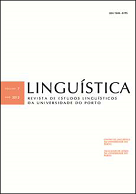“Vou buscar ali, ali acima!” A multimodalidade da deixis no português europeu
Resumo
Com base num estudo de caso, explora-se a deixis multimodal - a deixis composta por gesto e fala - no português europeu. Serão identificadas várias formas de gestos de apontar e, em seguida, correlacionadas com a fala simultânea. Dar-se-á conta dos diferentes tipos de deixis e das referências estabelecidas pelos elementos deíticos. Na descrição das modalidades que desempenham a função de “apontar para”, considerar-se-ão aspetos cotextuais e contextuais: a relevância de indicar um objeto, lugar, espaço, pessoa ou uma ideia abstrata; a necessidade de precisão no apontar; as expetativas do falante relativamente ao conhecimento do ouvinte sobre os referentes.
Referências
Auer, P. 1992. Introduction: John Gumperz’ approach to contextualization. In: P.Auer & A. Di Luzio (Eds.) The constextualization of language. Amsterdam: John Benjamins, 1-37.
Butterworth, G. 2003. Pointing is the royal road to language for babies. In: S. Kita (Ed.) Pointing. Where Language, Culture and Cognition Meet. New Jersey, Lawrence Erlbaum Associates, Publishers, 9-68.
Butterworth, B & Hadar, U. 1989. Gesture speech and computational stages: a reply to McNeill. Psychological Review, 96, 1, 168-174.
Bühler, K. 1965 [1934]. Sprachtheorie. Stuttgart: G.Fischer Verlag.
Carvalho, J.G.H. 1983 [1967]. Teoria da Linguagem. Natureza do fenómeno linguístico e a análise das línguas, Volume I, 6ª edição, Coimbra, Coimbra Editora Limitada.
De Jorio, A. (2000) [1832]. Gesture in Naples and gesture in Classical Antiquity: A translation of La mimica degli antichi investigate nel gesture napoletano, 1832. Blooomington: Indiana University Press.
Duranti, A. & Goodwin, C. (Eds.) 1997. [1992] Rethinking context. Language as an interactive phenomena. Cambridge: Cambridge University Press.
Efron, D. 1972 [1941]. Gesture, race and culture. The Hague: Mouton.
Ekman, P. & Friesen, W. 1969. The repertoire of nonverbal behaviour: categories, origins, usage and coding. Semiotica 1, 1, 49-98.
Feyerwreisen, P. 1987. Gestures and speech, interactions and separations: A reply to McNeill. Psychological Review 94, 4, 493-498.
Fillmore, C. 1975. Santa Cruz lectures on Deixis 1971. Bloomington, Indiana University Linguistics Club.
Fonseca, F.I. 1992. Deixis, tempo e narração. Porto: Fundação Eng.º António de Almeida.
Fonseca, F. I. 1996. Deixis e pragmática linguística. In: I.H.Faria, E. R. Pedro, I. Duarte & C. Gouveia (Orgs). Introdução à Linguística Geral e Portuguesa. Lisboa, Caminho, 437-445.
Galhano-Rodrigues, I. 2007. O corpo e a fala. Sinais verbais e não-verbais na interação face a face. Lisboa, FCG/FCT.
Galhano-Rodrigues, I. 1998. Sinais conversacionais de alternância de vez. Porto: Granito Editores e Livreiros.
Goldin-Meadow, S. 2003. Hearing Gesture. How hands help us think. Harvard, Harvard University Press.
Gumperz, J. & Hymes, D. 1964. The ethnography of communication. Special issue. American Anthropologist, 66, Part II.
Kallmeyer, W. & Schütze, F. 1976. Konversationsanalyse. Studium Linguistik 1,1-28.
Kendon, A. 2004 Gesture. Visible Action as Utterance. Cambridge, Cambridge University Press.
Kendon, A. (no prelo) Kinesic Components of Multimodal Utterances. Paper presented at the 36th Meeting of the Berkeley Linguistics Society, Berkeley, California, February 2009. A publicar em: Proceedings of the Berkeley Linguistics Society, vol. 39.
Kendon, A. & Versante, L. 2003. Pointing by hand in “Neapolitan”. In: S. Kita (Ed.) Pointing. Where Language, Culture and Cognition Meet. New Jersey, Lawrence Erlbaum Associates, Publishers, 109-137.
Kerbrat-Orechioni, C. 1990/1992. Les interactions verbales. Vol.I, II. Paris, Armand Colin.
Kita, S. (Ed.) 2003. Pointing. Where Language, Culture and Cognition Meet. New Jersey, Lawrence Erlbaum Associates, Publishers, 307-327.
Levinson, Stephen C. 1983. Pragmatics. Cambrige: CUP.
McNeill, D. 1985. So you think gestures are nonverbal? Psychological Review 92, 3, 350-371.
McNeill, D. 1987. So you think gestures are nonverbal! A reply to Feyereisen. Psychological Review 94, 4, 499-504.
McNeill, D. 1992. Hand and Mind.Chicago: Chicago University Press.
McNeill, D. 2003. Pointing and Morality in Chicago. In: S. Kita (Ed.) Pointing. Where Language, Culture and Cognition Meet. New Jersey, Lawrence Erlbaum Associates, Publishers, 293-306.
Núñez, R., & Sweetser, E. 2006. With the Future Behind Them: Convergent Evidence From Aymara Language and Gesture in the Crosslinguistic Comparison of Spatial Construals of Time. Cognitive Science, 30(3), 401-450.
Poggi, I. 2007. Mind, Hands, Face and Body. A goal and belief view of multimodal communication. Berlin: Weidler Verlag.
Pokorny, J. 1959. Indogermanisches Etymologisches Wörterbuch. In: http://indo-european.info/pokorny-etymological-dictionary/index.htm (última consulta: 10.04.2012).
Sherzer, Joel (1973). Verbal and non-verbal deixis: the pointed lip gesture among the San Blas Cuna. Language in Society 2: 117-131.
Selting, M. & Couper-Kuhlen, E. (Eds.) 2001. Studies in Interactional Linguistics. Amsterdam: John Benjamins.
Selting, M., Auer, P., Barden, B., Bergman, J., Couper-Kuhlen, E., Günthner, S., Meier, C., Quasthoff, U., Schlobinski, P. & Uhmann, S. 1998 Gesprächsanalytisches Transkriptionssystem (GAT). Linguistische Berichte 173, 91-122.
Vasconcellos, J. L. 1886. A evolução daLinguagem. Ensaio Antropológico apresentado á eschola medica do Porto como dissertação inaugural. Porto, Typographia Occidental. In: repositório aberto, U.P. http://repositorio-aberto.up.pt/handle/10216/16417, última consulta: 15 de março de 2012.
Watzlavick, P., Beavin-Bavelas, J. & Jackson, D. 1967. Pragmatics of Human Communication. A study of Interational Patterns, Pathologies and Paradoxies. New York: W.W.Norton Co.
Downloads
Publicado
Edição
Secção
Licença
Direitos de Autor (c) 2017 Linguística Revista de Estudos Linguísticos da Universidade do Porto

Este trabalho encontra-se publicado com a Creative Commons Atribuição-NãoComercial 4.0.



